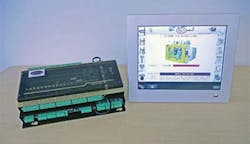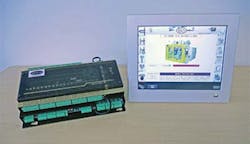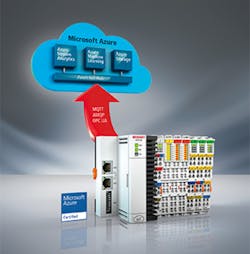Special Report: Blow molding controls provide more choices
Companies that supply machine controls are developing new products that offer blow molders more options for software, HMIs and the integration of downstream and upstream components.
Maco-sys LLC
Maco-sys LLC was formerly part of Eurotherm by Schneider Electric. The Machesney Park, Ill., company, led by President Dave Spahr, is coming out this month with a new product for blow molding control: the Opti-Pak BM. It offers total machine control while meeting the performance criteria of high-end market segments.
Based on its Opti-Pak line, which was originally targeted for injection molding, Opti-Pak BM is designed with smaller machines in mind.
The Opti-Pak BM has the right number of temperature loops for smaller machines and offers both analog and digital I/O, Spahr said. It's compatible with any of the company's HMI options, including its PC-based 19-inch model and an 8-inch Windows CE version.
"There are small blow molding machines from Asia that still use a single-loop controller, a PLC and an interface, so the effect is that of a discrete control," Spahr said.
The company's goal was to simplify the operator interface, which in blow molding is often centered around the parison profile target.
"What we try to do is give a good starting point for the OEMs, so we were just fine-tuning some of the application layer program, making it pre-packaged and thus minimizing the time to utilize [it]," Spahr said. The company's preferred practice is to select a couple OEMs to tweak its new lines.
The Opti-Pak BM's analog processing unit provides control functions (auto-tuning and motion control within the processor and its software) using Maco-sys blocks, or clusters of control.
"Basically, [you set] it up by indicating how many zones you want to enable, and our analog processing unit executes those functions," making it simple for general employees to manage, Spahr said.
The product is scalable by using multiple units or remote input/output (I/O) communication. Ethernet communications make expansion possible. Users can expand from the six analog inputs and four outputs of the basic Opti-Pak BM, along with 12 thermocouple (TC) loops. Up to six Opti-Pak BMs can be connected to provide as many as 72 zones of temperature control for multilayer machines.
Breaking away from Eurotherm and becoming a separate company will enable Maco-sys to specialize in plastics. "What it allows us to do is focus on plastics completely and allows [us to] be a lot more agile and make decisions on moving forward," Spahr said. "We hope to move things forward quicker, and obviously we end up having the benefit of [having the] hardware still manufactured where it has been for some time."
Maco-sys provides HMIs with high-resolution screens measuring 12, 15 and 19 inches, including some relatively new versions in the two smallest sizes. "You know everybody wants higher resolution, more information available but kept simple on the screens."
The company has been working on developing apps for smartphones and tablets, which will make machine information more accessible and easier to use. "It all ties into what is being done with IoT [the Internet of Things] and Industry 4.0," he said. "For a long time, we've had the data available, but nobody was really using it; you could collect a lot of data, but a lot of times the data was collected on the machine but not really scrutinized or utilized to do things like figuring out wear on the bearings.
"For blow molding machines, that kind of data can be analyzed, and a lot of the big players like Microsoft, Cisco and Bosch and some of those are coming up with packages to allow that data to be looked at and collected. More portions of the machine now have that capability," Spahr said.
The control system on HMIs could be key to pulling in that data and making it universally available for functions such as planning for scheduled maintenance.
The controls provide greater access to data — and the tools to leverage it.
"In blow molding, there are a lot of smaller companies that end up doing a good portion of production, and some smaller facilities sometimes just didn't want that additional burden or dealing with that kind of a complex data setup," Spahr said. "But that's all changing very rapidly."
OEMs increasingly are moving from hydraulic to electric machines. That allows machines to run faster but can lead to increased wear. Controls can help monitor that situation, Spahr said.
Blow molders also are using a wider variety of materials than ever before, and they need tools such as data collection/analysis and advanced control systems to allow them to monitor more variables. "People's expectations [are] just to tell it [the machine] what you want it to do, and then have it take the time to write the code that it takes to do the process that needs to be done," he said.
The biggest challenge is reaching the point where all pertinent data can be gathered, thus providing the most information for the most precise control.
"Blow molding has always been somewhat of an art rather than a science. You drop the parison down in the air, so you're not completely controlling that environment. Humidity can factor in," Spahr said. "Now they're starting to have the [software] tools available that really analyze the current occurrence and correct. [It's] a science rather than an art."
Beckhoff Automation
Beckhoff Automation LLC, Savage, Minn., has been a major supplier of interfaces for Industry 4.0 applications, said Thomas Kosthorst, business development manager, plastics processing machines. The company sees a shift to greater use of servo drives as a general trend in controls for blow molding. "I think we are in a good stage with this because we have vast experience with servo drives," he said. "Beckhoff controllers are prepared for all control concepts, however, including hydraulic, servo and also for hybrid-drive concepts."
This equipment continues to get more sophisticated. Machines increasingly are just part of a bigger cell with integrated, advanced robots. Beckhoff's own Ethernet product, EtherCat, has become a prime part of the company's control platform. "Ethernet connectivity is one of the most important functions of the controller, because it's the nerve center and the data line between all the different machine components," Kosthorst said.
Display panels are getting larger; companies are requesting 19-inch, 21.5-inch and 24-inch screens with multitouch operation. The integration of tools and services that address both Industry 4.0 concepts is becoming more critical. With its TwinCat analytics, Beckhoff can provide software that analyzes data sent to the cloud. One example is condition-monitoring software, which helps machine operators detect any developing problems as soon as possible. It can also analyze production stability and efficiency. "This big-data analysis can easily explain how effectively the machine works, down to every part it makes," Kosthorst said.
Allan Gerlat, correspondent
Contact:
Beckhoff Automation LLC, 952-890-0000, www.beckhoffautomation.com
Maco-sys LLC, 815-341-2637, www.maco-sys.com


